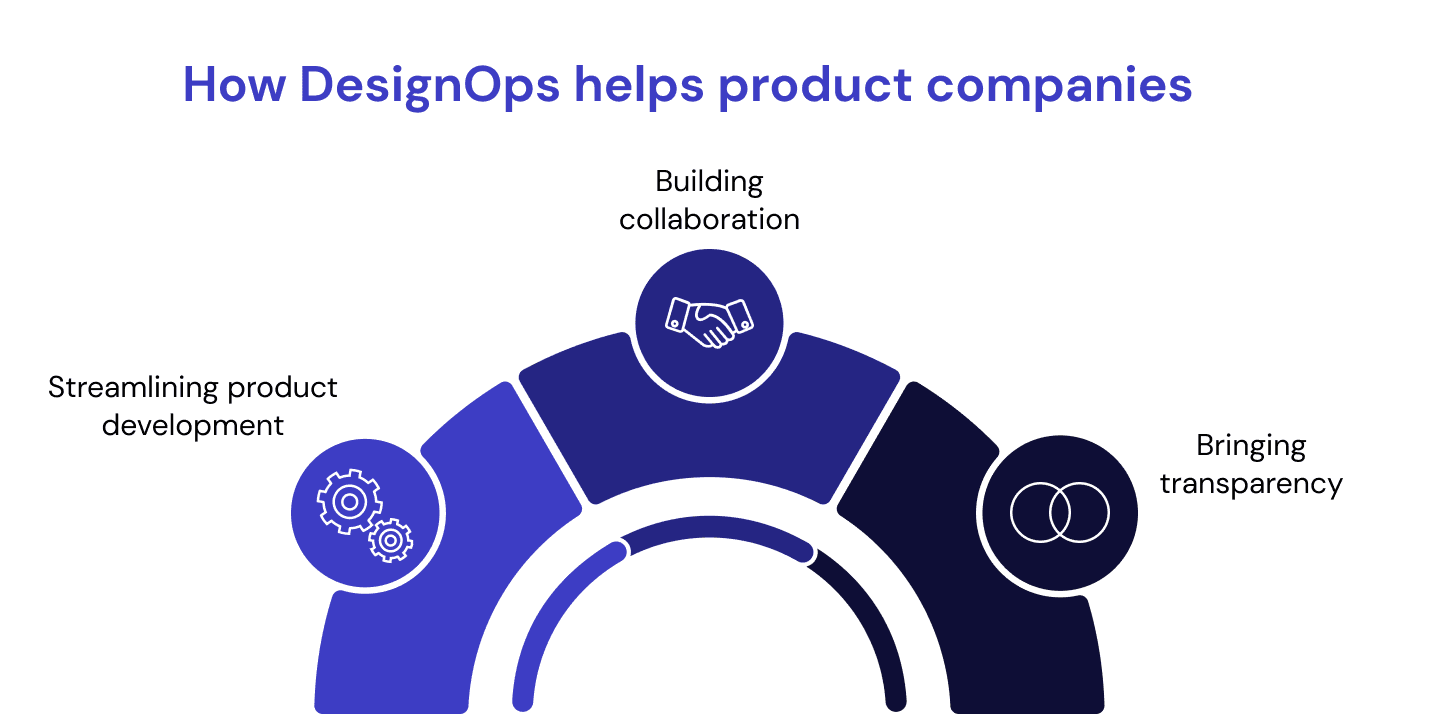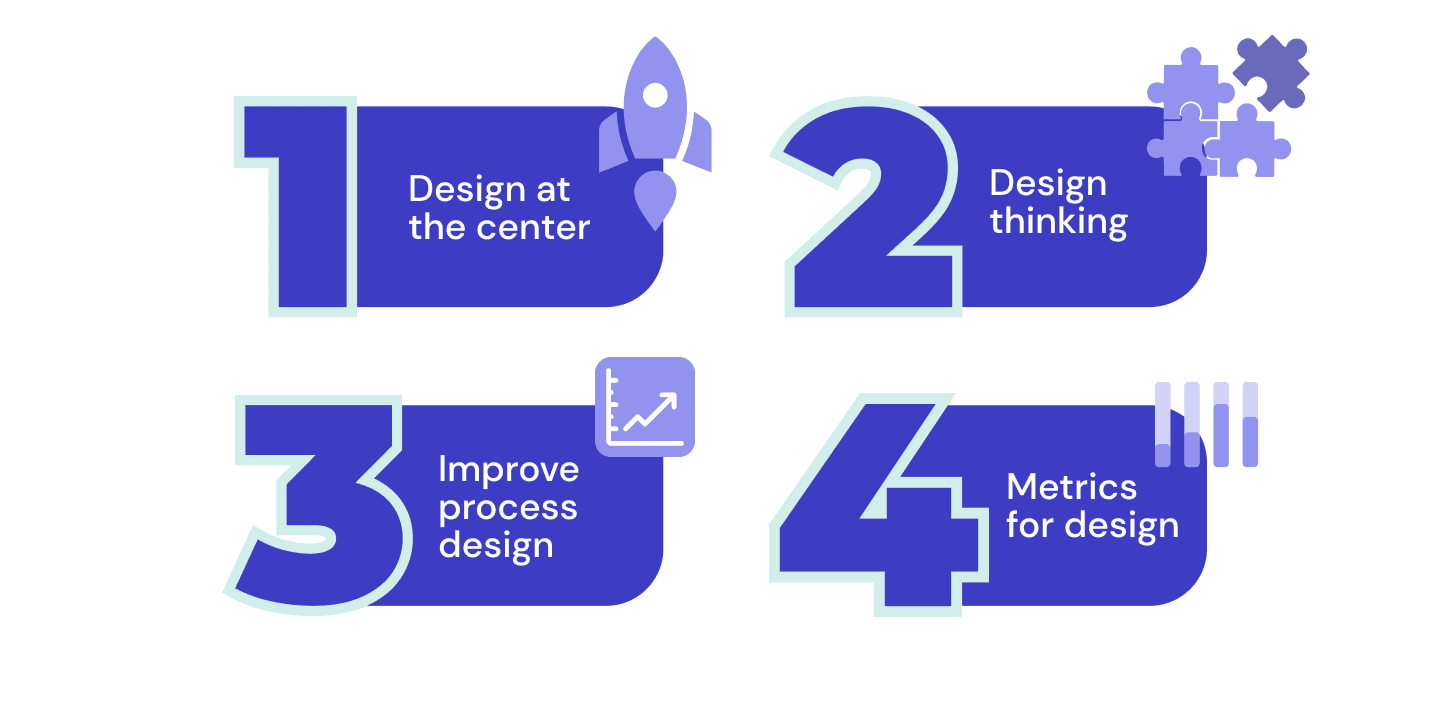Why DesignOps is the future for product companies

DesignOps and design thinking have started to impact the ideologies and workflows of product companies worldwide. Companies like AirBnb and Honeywell popularized DesignOps as the solution to building scalable design functions.
Today, product companies worldwide are slowly inclining towards design ideology to streamline their product cycles. The growing demand for elegant UX has also added wind to the sails of the DesignOps movement.
So why are product companies starting to pay attention to DesignOps? And how does it play into the future of product companies? In this article, we explore the connection between product companies and design thinking.
Let’s get started.
How DesignOps helps product companies
DesignOps helps product companies build a highly collaborative ecosystem for design and non-design stakeholders to work together to optimize processes, people, and products to drive desirability and impact.
Numerous companies employ full-time DesignOps leaders who ensure that all organizational stakeholders consistently maintain DesignOps processes.
Although this approach isn’t mandatory, establishing a DesignOps mindset and framework alone helps organizations:
- Grow consistently,
- Evolve with rising demand,
- Hire the right employees,
- Create smooth and efficient workflows, and
- Increase the quality and impact of outputs.
DesignOps additionally allows businesses to take a design-led approach to product design to maximize scalability and rise above the competition.
Also read: Why DesignOps is essential to the product development process.
Let’s dive into what you can achieve by adapting to DesignOps as your primary driver of product design.

Streamlining product development
DesignOps is an effective framework that curbs bureaucracy and complexities in the product cycle, smoothening product development, eliminating redundancies, and offering a uniform design language for all organizational actors to work.
A well-devised DesignOps strategy can help product designers, developers, and all teams speak the same design language during the product cycle.
Additionally, it supports all product teams using uniform styles, grids, typography, and colors for consistent product design.
Building collaborative design teams
Assembling a team of highly skilled design recruits does not automatically translate to quality outputs. A critical factor defining the success of design teams lies in the ability of each player to make a collaborative effort to design the best outcomes.
Achieving these factors can be increasingly tricky when expecting teamwork between product teams that are regularly scaling.
How can your design team remain collaborative and productive while continually growing with recruits? Your answer is DesignOps.
Through DesignOps, you provide the framework necessary for all teams to follow. The DesignOps system allows businesses to predefine control of the structures everyone operates on and ensures that all actors stay within the confines of the business’s vision.
Teams are increasingly collaborative, and integrating recruits to design teams is almost instantaneous via proper design playbooks.
Collaboration between teams can be especially tricky when dealing with geographically separated designers or teams. In such instances, the lack of effective communication hampers decision-making and workflow.
A well-orchestrated DesignOps strategy and a common design language for all stakeholders reduce these concerns.
Bringing transparency to the design process
Transparency in the design process plays a mega impact on product outcomes. Streamlined DesignOps bridge the communication gap between design actors boosting consistency in the process throughout product companies’ ecosystems.
A lack of transparency is especially the case when several remote and non-remote design teams work on a product-by-product basis. Here, excellent communication and transparency are vital for the best outcomes.
Picture two product teams working on two separate products.
Although both products differ from each other, they still need to be accurate representations of the brand image. It’s challenging for multiple remote and non-remote design teams to achieve this when the design process lacks transparency.
Lacking transparency will eventually lead to mismatched designs, brand misrepresentation, and sourcing of different elements and components for product design.
DesignOps, on the other hand, provides everything designers need for output consistency as a single source of truth. Designers are always kept in the loop of other teams’ progress and often work together to achieve design consistency.
Another significant benefit of increased transparency is increased trust between design and non-design actors. Building this trust between management and product teams becomes effortless when product expectations, work hours, wages, project status, and timelessness are all easily viewable through a DesignOps system.
Now, for the main question…
Why DesignOps is the future of processes at product companies
Today, leading product companies are beginning to recognize that bringing design thinking to the core of product design is an effective way to solve product design problems quickly, innovatively, and creatively.
Here are some ways DesignOps is proving to be the ultimate tool for businesses to get future-ready.
Bring product design to the center
DesignOps moves the spotlight back on product design, where it belongs.
Rather than selecting high-quality, expensive designers and hoping for excellent outputs, DesignOps lets companies gauge what the product requires. Then, recruits are chosen based on the unique product requirements instead of the other way around.
This approach allows businesses to streamline the costs associated with expensive recruiting and increases their probability of making the right engagements.
Remember, with design in the center, products will flourish.
Integrate design thinking
Design thinking is not always easily achievable with numerous mindsets and conflicting working styles in the product design ecosystem.
DesignOps can help businesses structure the ecosystem so that common goals are efficiently achieved even through varying mindsets.
Design thinking helps product companies achieve this by following five simple steps:
- Empathize,
- Define,
- Ideate,
- Prototype,
- Test.
Integrating user-centric design processes through these five steps can provide much-needed flexibility and adaptability to the design process to suit unique product requirements.
Rework process design across the organization
Business processes and workflow define the quality of product outputs. Product companies with complicated design processes and workflows often cause misalignment between teams, leading to disorganized outcomes.
A better practice would be to simplify the design process entirely to reduce the chances of making errors.
Quantifying processes
Measuring the performance and impact of DesignOps is integral for managers to perform decision-making and acquire buy-ins from stakeholders.
In DesignOps-led businesses, KPIs and metrics measure every stage of the design process and ROI. These performance indicators help the business identify and rectify complicated processes hampering UX and DesignOps.
It also allows product companies to constantly increase the system’s efficiency by eliminating hidden inefficiencies and streamlining all individual processes.
Some of the hidden inefficiencies that DesignOps help mitigate are inconsistencies in workflows, inadequate collaboration across functions, inconsistencies in templates, lacking proper processes, and lacking the right tools.
New inefficiencies in the product cycle crop up every time businesses add new processes or change existing processes. Eliminating them to the maximum extent is an iterative process. The effectiveness of applied resolutions and further inefficiencies are identifiable through quantifying processes.
In conclusion, if your business is suffering from substandard products and inefficient processes, it could be lucrative to explore the scope of improvement DesignOps could bring.
Remember, a DesignOps strategy to work requires acceptance from the collective organizational mindset starting with you. Truly great product companies aim to provide valuable and satisfactory products to the customer at a feasible cost.
Instead, shifting focus to design can help business design and non-design stakeholders work together toward achieving common product goals.
Paving the future of your product design through Cubyts
Cubyts’ DesignOps Platform is designed for design experts and leaders to eliminate inefficiencies in the design workflow, establish design processes, run design projects, and track metrics.
If you have any questions or are looking at jumping into the DesignOps space, feel free to get in touch with us!
